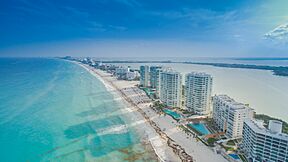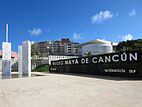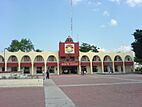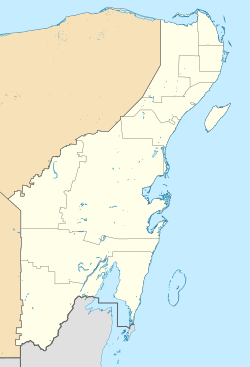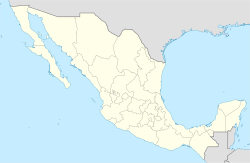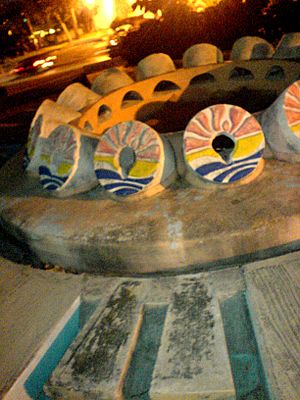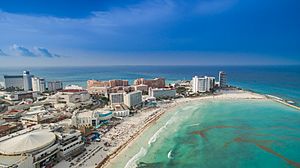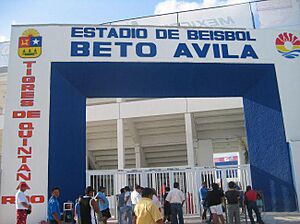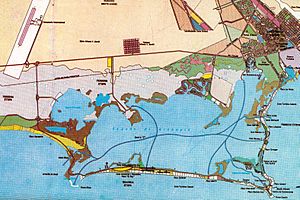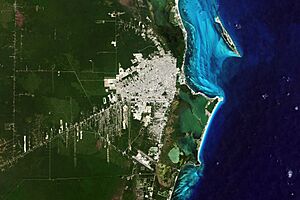Cancún facts for kids
Quick facts for kids
Cancún
|
|||
|---|---|---|---|
|
Cancun skyline
Kukulcan Boulevard
Memorial obelisk
San Miguelito Ruins
Mayan Museum of Cancun
Municipal palace
Lighthouse
El Rey Archaeological Site
|
|||
|
|||
| Country | |||
| State | |||
| Municipality | |||
| Founded | April 20, 1970 | ||
| Area | |||
| • Land | 142.7 km2 (55.1 sq mi) | ||
| Elevation | 10 m (30 ft) | ||
| Highest elevation | 10 m (30 ft) | ||
| Lowest elevation | 0 m (0 ft) | ||
| Population
(2020)
|
|||
| • City | 628,306 | ||
| • Density | 4,400/km2 (11,000/sq mi) | ||
| • Metro | 1,045,005 | ||
| Demonym(s) | Cancunense | ||
| GDP (in 2015 PPP) | |||
| • Year | 2023 | ||
| • Total | $18.5 billion | ||
| • Per capita | $18,100 | ||
| Time zone | UTC−5 (EST) | ||
| Postal code |
77500
|
||
| Area code(s) | 998 | ||
| Federal Routes | |||
Cancún is a very popular city in Mexico. It is located in the state of Quintana Roo, on the northeast coast of the Yucatán Peninsula. This city is a major tourist spot in Mexico. It is also the main city of the Benito Juárez area. Cancún sits right on the Caribbean Sea and is one of the easternmost places in Mexico. It is just north of the famous Riviera Maya resort area.
Contents
What's in a Name? The Story of Cancún
The island of Cancún was first known as Nizuc to its Maya inhabitants. This name meant 'promontory' or 'point of grass'.
The name Cancún started appearing on maps in the 1700s. It comes from the Mayan words kàan kun. Kàan means 'snake', and kum or kun means 'to swell' or 'overfill'.
So, Cancún is often thought to mean 'nest of snakes'. Another idea is 'place of the golden snake'. Snakes were important symbols at the ancient site of Nizuc.
The Coat of Arms
The shield for the Benito Juárez area, which includes Cancún, was designed by artist Joe Vera. It has three parts.
- Blue stands for the Caribbean Sea.
- Yellow represents the sandy beaches.
- Red symbolizes the sun and its bright rays.
Cancún's History: From Coconut Plantation to Tourist Hub
After the Spanish conquest of Yucatán, many Maya people died or left. This was due to diseases, wars, and famines. Only small settlements remained on nearby islands like Isla Mujeres and Cozumel Island.
Cancún is a planned city. It was created specifically to attract tourists. When development began on January 23, 1970, Isla Cancún had only three residents. They were caretakers of a coconut farm. About 117 people lived in the nearby fishing village of Puerto Juárez.
The Mexican government wanted to boost tourism. In 1967, they set aside money to see if new resort areas could be built. This led to the creation of Cancún.
At first, investors were unsure about putting money into an unknown area. So, the Mexican government paid for the first nine hotels.
Cancún officially started as a tourism project in 1974. It was a new kind of planned center by FONATUR. This group helps develop tourism in Mexico. Since then, Cancún has changed a lot. It went from a small island to one of Mexico's most famous resorts.
Most people in Cancún today come from other parts of Mexico. Many also come from other countries in the Americas and Europe. The city has grown very quickly. In 2023, a record 21 million tourists visited Cancún.
Geography and Climate
City Layout
Cancún has two main parts. There's the island tourist zone, which is part of a large coral reef system. Then there's the mainland, where most Mexican residents live. The downtown area, "El Centro," was planned with "superblocks." These are large areas with a central open space and U-shaped streets for homes.
New developments are still being built. These include areas like Puerto Cancún and Malecon Cancún.
Climate
Cancún has a tropical climate. This means it's hot all year round. Sea breezes help keep temperatures from getting too high. There are clear rainy and dry seasons. The rainy season is from late August to November. The dry season runs from November to April.
The hurricane season is from June to November. The hotel zone is surrounded by the ocean. This keeps daytime temperatures a bit cooler there. The sea water is always very warm. It stays around 26 °C (79 °F) (79 °F (26 °C)) in winter and 29 °C (84 °F) (84 °F (29 °C)) in summer.
| Climate data for Cancún | |||||||||||||
|---|---|---|---|---|---|---|---|---|---|---|---|---|---|
| Month | Jan | Feb | Mar | Apr | May | Jun | Jul | Aug | Sep | Oct | Nov | Dec | Year |
| Record high °C (°F) | 33 (91) |
38 (100) |
39 (102) |
38 (100) |
39 (102) |
39 (102) |
39 (102) |
41.5 (106.7) |
38.5 (101.3) |
38 (100) |
37 (99) |
33.5 (92.3) |
41.5 (106.7) |
| Mean daily maximum °C (°F) | 28.3 (82.9) |
29.4 (84.9) |
30.7 (87.3) |
32.2 (90.0) |
33.5 (92.3) |
33.7 (92.7) |
34.3 (93.7) |
34.8 (94.6) |
33.7 (92.7) |
31.6 (88.9) |
29.8 (85.6) |
28.6 (83.5) |
31.7 (89.1) |
| Daily mean °C (°F) | 24.1 (75.4) |
24.8 (76.6) |
25.8 (78.4) |
27.4 (81.3) |
28.7 (83.7) |
29.2 (84.6) |
29.5 (85.1) |
29.7 (85.5) |
29 (84) |
27.5 (81.5) |
25.9 (78.6) |
24.5 (76.1) |
27.2 (81.0) |
| Mean daily minimum °C (°F) | 19.8 (67.6) |
20.3 (68.5) |
21.0 (69.8) |
22.6 (72.7) |
23.9 (75.0) |
24.7 (76.5) |
24.8 (76.6) |
24.6 (76.3) |
24.3 (75.7) |
23.3 (73.9) |
21.9 (71.4) |
20.5 (68.9) |
22.6 (72.7) |
| Record low °C (°F) | 13 (55) |
12 (54) |
9.5 (49.1) |
14 (57) |
18 (64) |
20.5 (68.9) |
21 (70) |
20 (68) |
19 (66) |
15 (59) |
12 (54) |
12 (54) |
9.5 (49.1) |
| Average rainfall mm (inches) | 104.6 (4.12) |
49.5 (1.95) |
44.1 (1.74) |
41.2 (1.62) |
86.9 (3.42) |
138.3 (5.44) |
77.9 (3.07) |
87.5 (3.44) |
181.9 (7.16) |
271.9 (10.70) |
130.3 (5.13) |
86.1 (3.39) |
1,300.2 (51.19) |
| Average rainy days (≥ 0.1 mm) | 9.4 | 5.9 | 5.0 | 4.1 | 6.7 | 11.0 | 9.3 | 9.7 | 14.0 | 16.4 | 11.4 | 9.8 | 112.7 |
| Source: Servicio Meteorológico Nacional (1951–2010) | |||||||||||||
| Jan | Feb | Mar | Apr | May | Jun | Jul | Aug | Sep | Oct | Nov | Dec |
|---|---|---|---|---|---|---|---|---|---|---|---|
| 79 °F
26 °C |
79 °F
26 °C |
79 °F
26 °C |
81 °F
27 °C |
82 °F
28 °C |
84 °F
29 °C |
84 °F
29 °C |
84 °F
29 °C |
84 °F
29 °C |
84 °F
29 °C |
82 °F
28 °C |
81 °F
27 °C |
Tropical Storms and Hurricanes
The tropical storm season in Cancún lasts from May to December. The rainiest months are usually in October. Cancún is in an area where hurricanes can happen. Big hurricanes are rare, but they have hit the area.
- Hurricane Gilbert hit in September 1988. It caused a lot of damage, and hotels had to be rebuilt.
- Hurricane Wilma hit in October 2005. It was a very strong hurricane.
- Hurricane Dean hit in 2007. It caused strong winds that removed sand from many beaches.
When hurricanes approach, authorities work to keep tourists and residents safe. They often ask airlines to send empty planes to help evacuate people.
Cool Places to Visit in Cancún
Old Airport Control Tower Memorial
Cancún is a young city, but it has a special monument to its beginning. It's a copy of the old Airport Control Tower. This tower reminds people of the day Cancún was founded.
The first control tower was made of wood. It was built in 2002 but was damaged by Hurricane Wilma in 2005. People wanted it rebuilt, and a new one was put up in 2010. It was later fixed up to look like the original.
El Ceviche Fountain
This famous monument is officially called "Caribbean Fantasy." It's in the middle of downtown Cancún, at a busy intersection. It has seen many important events over the years.
In 1981, a big meeting called the North-South Summit was held in Cancún. Two metal pillars were built for this event. They looked like a stepped pyramid and had flags of the countries attending. The artist, Lorraine Pinto, added details like the ancient god Quetzalcoatl.
In 1994, the monument was damaged by Hurricane Gilbert. Locals started calling the damaged structure "Insectronic" because of its bare look. Later, Lorraine Pinto helped create a new design for the fountain. People now call it the Ceviche Fountain.
Ancient Maya Sites
Cancún has some small ruins from the ancient Maya civilization.
- El Rey (Las Ruinas del Rey) is located right in the Hotel Zone.
- El Meco, a larger site, is just outside the city on the way to Punta Sam.
Nearby, in the Riviera Maya, you can find other amazing Maya sites. These include Cobá, Muyil, and Tulum. The very famous Chichén Itzá is in the neighboring state of Yucatán.
Sports in Cancún
Cancún is home to several sports teams.
- Cancún F.C. is a football (soccer) team. They play in the Liga de Expansión MX, which is Mexico's second division. Their home stadium is the Estadio Andrés Quintana Roo.
- The Pioneros de Cancún also play football in a lower league.
- The Tigres de Quintana Roo are a baseball team. They play in the Mexican League (LMB).
In October 2023, Cancún hosted the WTA Finals for women's tennis. A temporary stadium was built for the event. Some players felt the facility was not ready for such a high-level competition.
Getting Around Cancún
Cancún is served by the Cancún International Airport. It has many flights to North America, Central America, South America, and Europe. About 15 million passengers use this airport each year. The airport is about 20 kilometres (12 mi) (12 miles (19 km)) from the hotel zone.
The island of Isla Mujeres is close by. You can reach it by ferry from Puerto Juárez or Playa Tortugas. Since 2020, most international visitors flying into Quintana Roo need to pay a new tax called VisiTAX.
Cancún also has bus lines. These connect the downtown area, the hotel zone, and other cities like Playa del Carmen and Tulum.
The Tren Maya is a new train system. It started running in December 2023. This train connects Cancún to Palenque, Chiapas and other places on the Yucatán peninsula.
Sister Cities
Cancún has special connections with other cities around the world. These are called sister cities.
- Wichita, Kansas, USA – since 1975
- Timișoara, Romania – since 2019
- Naperville, Illinois, USA – since 2021
See also
 In Spanish: Cancún para niños
In Spanish: Cancún para niños


